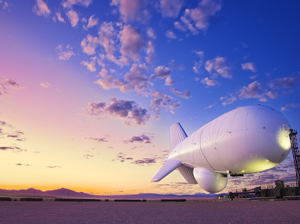 Now, after a six-week-long “test-drive” in the Utah wilderness, U.S. Army soldiers are ready to take full control of Raytheon’s enormous JLENS airships. Next stop: Aberdeen Proving Ground in Maryland, where the twin-radar system will begin a long-term trial watching over Washington, D.C.
Now, after a six-week-long “test-drive” in the Utah wilderness, U.S. Army soldiers are ready to take full control of Raytheon’s enormous JLENS airships. Next stop: Aberdeen Proving Ground in Maryland, where the twin-radar system will begin a long-term trial watching over Washington, D.C.
JLENS – which is short for Joint Land Attack Cruise Missile Defense Elevated Netted Sensor System – is a system of two aerostats, or tethered airships, that float 10,000 feet in the air. The aerostats, each nearly as long as a football field, carry powerful radars that can look deep into enemy territory.
The threat is real
Swarming boats, anti-ship cruise missiles, mine laying ships and unmanned aircraft. These are only some of the dangers the Warfighter faces on the modern battlefield.
That capability exists today. It’s called JLENS. And it’s made by Raytheon.
JLENS, an affordable elevated, persistent over-the-horizon sensor system uses a powerful integrated radar system to detect, track and target a variety of threats. This capability better enables commanders to defend against threats including hostile cruise missiles, low-flying manned and unmanned aircraft, tactical ballistic missiles, large caliber rockets, and moving surface vehicles such as boats, SCUD-launchers, automobiles, and tanks.
What is JLENS?
• A JLENS system, referred to as an orbit, consists of two tethered, 74-meter helium-filled aerostats connected to mobile mooring stations and a communications and processing groups.
•The aerostats fly as high as 10,000 feet above sea level and can remain aloft and operational for up to 30 days.
•One aerostat carries a surveillance radar with 360-degree surveillance capability; the other aerostat carries a fire control radar.
Why is JLENS affordable?
One JLENS orbit can provide the same 24/7 coverage for a 30-day period that 4-5 fixed wing surveillance aircraft (AWACS, JSTARS or E-2C) can provide.
• Depending on the kind of aircraft used, a fixed-wing surveillance aircraft is 500-700% more expensive to operate than a JLENS during that same time period because of manpower, maintenance and fuel costs.
• A JLENS orbit uses less than 50% of the manpower it requires to fly a fixed wing aircraft. (That’s not counting the ground-support personnel required to launch a sortie).
Source: Raytheon Company
Recent News: US Army soldiers test JLENS in real-world scenarios– July 24, 2013
FP National Security: Breaking the Kill Chain– May. 16, 2013
Raytheon Missile-Seeking Blimp to Get Test Run Guarding Capital – Feb. 28, 2013
JLENS demonstrates tactical ballistic missile defense capability– Feb. 19, 2013
Raytheon says aces missile-detection tests in U.S.– Feb. 18, 2013
REFILE-Blimps to bolster Washington’s air shield in test– Feb. 4, 2013
Fort Sill Soldier Army’s top air defender– Jan. 29, 2013






